 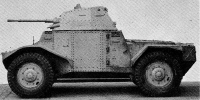
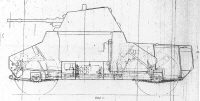 |
AMD Panhard 178 |
Length : 4.79m
Width : 2.01m
Height : 2.31m
Crew : 4 men
Maximum armor : 26mm (turret and hull is RHA bolted armor)
Maximum speed : 72.6 km/h (Panhard ISK 4F II bis engine, 8 cylinders,
gasoline, water cooled, 110hp, 2000 rpm)
Transmission : 4 forward, 4 reverse (dual drive)
Autonomy : 300 km
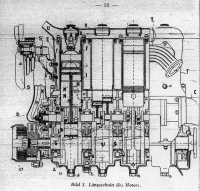
Detailed armor thickness (mm):
Turret Front : 26mm/24°
Turret Sides : 15mm/26°
Turret Rear : 15mm/30°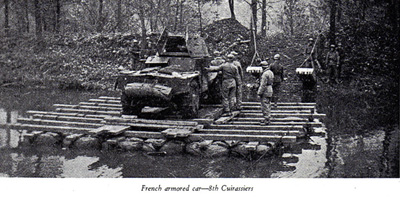
Turret Top : 7mm/82°
Hull Front : 20mm/21° and 0°
Hull Sides : 15-20mm/0°
Hull Rear : 15-20mm/41°
Hull Top : 7mm/90°
Hull Bottom : 7mm/90°
Onroad gear 1 : 13.8 km/h
Onroad gear 2 : 24.3 km/h
Onroad gear 3 : 40.1 km/h
Onroad gear 4 : 72.6 km/h
Offroad gear 1 : 8 km/h
Offroad gear 2 : 14 km/h
Offroad gear 3 : 23.1 km/h
Offroad gear 4 : 42 km/h
Backward gears : same speeds as offroad gears.
Turning circle at outer tire: 8 m
Maximum slope to climb on hard ground : 40°
Maximum slope to climb on soft ground : 22°
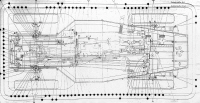
25mm SA35 (L/47.2 or L/60 ?) gun - in German service : 2.5cm KwK 121(f)
Theoretical rate of fire : 25 rpm against fixed target and 15 rpm against moving target
Telescopic sight : 4x (L.711 telescopic sight, with a 3450m range drum, field of view 10.13°, V reticle)
Practical AT range:
800m (heavy armored vehicles)
1000m (medium armored vehicles)
1500m (light armored vehicles and softskins)
Ammunitions:
Cartouche de 25mm Mle1934 ā balle perforante (charge forte) (AP) - in German service: Pzgr 122(f)
Caliber : 25x194R mm
Weight of projectile : 0.320 kg (steel/tungsten core)
Length of projectile : 109 mm
V° = 950 m/s (charge forte = 148g propellant powder more propellant to offset shorter barrel length)
Penetration : 40mm/0° at 500m; 32mm/35° at 200m
German tests :
The test was carried out 1/8-1941 with a 2,5cm KwK 121(f) by HWA on a 120 kg/mm2 armor plate (source : "Kennblätter fremden geräts heft 8a, Munition bis 3,6 cm" Released in Berlin 1941).
100 meters = 47mm /0°
500 meters = 40mm /0°
1000 meters = 30mm /0°
100 meters = 35mm /30°
500 meters = 30mm /30°
1000 meters = 20mm /30°
100 meters = 18mm /45°
500 meters = 16mm /45°
1000 meters = 15mm /45°
Cartouche de 25mm Mle1934 ā balle traįeuse perforante (charge forte) (APT) - in German service: Pzgr 123(f) Probably white tracer, tracer effect up to 2000m.
Cartouche de 25mm Mle1934 ā balle traįeuse perforante (charge forte) (APT) - in German
service: Pzgr 124(f) - Red tracer, tracer effect up to 2000m.
An excerpt from the Field Artillery
Journal: Road To Dunkirk
by Henri de la Falaise

EDITOR'S NOTE: Henri, Marquis de la Falaise, is a member of a distinguished
French family
having a military background, and several of his
close maternal relatives are oficers in the British army.
Educated at
Sorbonne University in Paris, he enlisted in the French cavalry (in 1915),
at the age of 17.
After active service at the front during 1915-18 he was
wounded severely,
but later volunteered for the tank corps and saw action
at St. Mihiel.
For his war service he was awarded the Croix de Guerre,
and received a second citation.
After the war he worked for various motion picture companies in
Hollywood,
and made films in Bali and French Indo-China.
During
1939-40 Marquis de la Falaise was a liaison oficer with the British.
For
his services in Flanders he was twice decorated, and after Dunkirk he returned
to France.
He was sent to a tank regiment in Brittany; this unit
was cut off and captured.
Marquis de la Falaise escaped and made his
way to the United States, where he is now living.
Some of the names mentioned in "Road to Dunkirk" are real, others
fictitious in order to protect individuals,
some of whom are now prisoners
in German hands. All events described are, of course, actual history.
I find Hoegarden to be a heap of smoking ruins. The colonel of the Cuirassiers is
with Cdt. Halbessart.
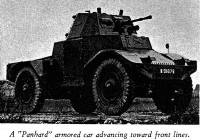
As I stand with him in a wrecked house, reports of the battle keep coming
in.
The Panhards are fighting like mad.
They have destroyed at least fifteen German tanks during the last hour.
Lt. de St. E. arrives, covered with blood. He stands smartly at attention
before the colonel, in his right hand a German helmet which is also dripping
with blood. Two German "Tommy-guns" are slung over his shoulder. He presents
these trophies to the colonel. His three Panhards have been put out of
action but he has managed to escape with the remainder of his peloton on
motorcycles. He asks to be given another car immediately. He has destroyed
five German light tanks near Opheilissen.
Source:
David Lehmann
The Field Artillery Journal
German Documents from the National Archives